Carl E. Olson's Blog, page 174
January 8, 2013
"There are zingers, and then there are Denzingers..."
From the most recent round of HPR book reviews, here is a review by Fr. Kenneth Baker, S.J., of an essential work for any serious teacher or student of theology:
ENCHIRIDION SYMBOLORUM. A COMPENDIUM OF CREEDS, DEFINITIONS,
AND DECLARATIONS ON MATTERS OF FAITH AND MORALS. By Heinrich
Denzinger; edited by Peter Huenermann for the German edition; edited by
Robert Fastiggi and Anne Englund Nash for the English edition,
Forty-Third Edition. (Ignatius Press, San Francisco, 2012), xxxviii +
1399 pp. HB $69.95.
There are zingers, and then there are Denzingers, to borrow a phrase
from Ralph McInerny. Denzinger has been a basic tool for all students
of Catholic theology since it first appeared in 1854. This is now the
forty-third edition of the 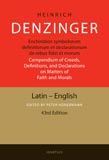 handbook of creeds and definitions that cover
handbook of creeds and definitions that cover
the basic teachings of the Catholic Church. It replaces the English
translation of Roy J. Deferrari, and also the version of J. Neuner, S.J.
and J. Dupuis, S.J., which does not present the whole text of the
original version.
This is a work of monumental scholarship. For serious scholarly
work, it is essential to compare the English translation with the Greek
and Latin originals. This is easy to do with this new edition because
the text is presented in double columns, with the original Greek and
Latin on the left, and the English translation on the right. It should
also be pointed out that this is a new, more exact translation, thanks
to the efforts of Dr. Fastiggi, who worked on this project for about ten
years.
The numbering of the documents follows the numbers of
Denzinger-Schoemetzer in the thirty-fourth, and following, editions. In
addition, the numbers now go into the five thousands: since the
documents of Vatican II are included, and also quotes from the major
encyclicals of the popes, from John XXIII to Benedict XVI. There is an
extensive index of subjects and persons, and also an appendix that gives
a concordance of marginal numbers with the editions before 1963.
The book is easy to use, with the marginal numbers in bold print, and
a running summary of the numbers, one on each page, printed at the top
of each page. This important edition now replaces all previous editions
of Denzinger.
The price of $69.95 is not unreasonable, given the large size of the
book, the excellent binding, and the ten years of effort that went into
the production of this essential tool for all Catholic theologians.
I urge all Catholic libraries to order a copy of this basic book. It
certainly should be in the library of every Catholic seminary, and
preferably on the desk of every seminarian who is studying for the
priesthood.
-Fr. Kenneth Baker, S.J., HPR Editor Emeritus
Tacoma, Washington
The systematic index mentioned by Fr. Baker is very impressive just on its own; it is nearly 200 pages long and it provides paragraph numbers for passages of "greater doctrinal importance", "references to a condemned teaching", as well as passages that indirectly touch on the topic at hand. As one would expect, there are indexes of Scripture references, documents, and persons and subjects. Expensive, yes. Essential, yes!
January 7, 2013
Roman Missal 3.0: Updates Installed
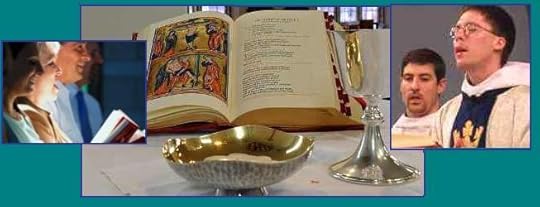
Roman Missal 3.0: Updates Installed | Fr. David M. Friel | Homiletic & Pastoral Review
As a revision, the Roman Missal 3.0 has, as its obvious intention, to be an improvement upon that which came before.
The last time I put a pencil to music manuscript paper was 2008.
That was the year I finally gave in and took advantage of my student
discount to purchase one of the mainstream software programs for musical
composition. I was absolutely delighted when it arrived, and I loaded
it onto my laptop immediately. It was a moment of true emancipation for
me as a freelance composer.
It was also the moment in which I became enslaved to unremitting
advertisements for the 2009 version of the program. Six months later,
the promotions began for the 2010 version. The commercials still come,
both by regular mail and by electronic mail, though fortunately not over
the phone. Software updates are standard procedure for those who
choose to live in the digital age; nevertheless, I find myself easily
exasperated with the arrival of each new promotion.
Almost a year has passed since the English-speaking world received “Roman Missal 3.0,” the new translation of the Missale Romanum Editio Typica Tertia.
Before its implementation in late November 2011, I encountered many
priests and laymen whose reaction to the announcement of a new missal
was as unenthusiastic as is my reaction to the promotional spam I
receive for my music software. And, just as I typically spend little
time investigating what improvements are being offered in the software
update, many (though not all) of these members of our Church had given
little time to the task of exploring what the new missal would offer.
As a revision, its obvious intention is to be an improvement upon that
which came before. But how, and in what ways?
This is too broad a question to be answered in fullness here, so I
will limit myself to present only five “updates” offered by the new
missal. These observations are not intended to constitute a
comprehensive analysis of the missal, nor do they necessarily represent
the largest or most significant improvements. Clergy and churchgoers,
at this point, will be familiar with the large-scale changes that have
occurred, but many perhaps have not plumbed the more minute aspects of
the revision. My hope is that the highlights that follow will serve at
least as fledgling insights into the treasures we have received.
"The Best Books I Read in 2012..."
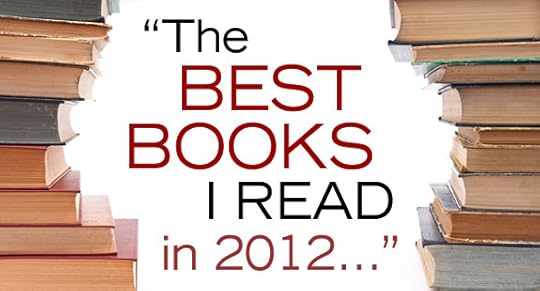
"Best Books I Read in 2012..." | 35 Contributors | Catholic World Report
Another year, another tantalizing list of good and great books noted and
recommended in this eighth edition of "Best Books I Read..." We've
invited a wide range of
authors and editors to contribute. The books chosen did not have to be
published in 2012, nor did they have to be about a specific topic.
Simply, "What were the best books
you read in the past year?" No limit was set on the number of books,
and commentary was optional.
PART ONE: Selections from Dale Ahlquist, Francis J. Beckwith, Bradley J. Birzer, Mark Brumley, John B.
Buescher, Anthony E. Clark, Eric Cunningham, David Paul Deavel, Thomas
M. Doran, Anthony Esolen, Monsignor Daniel B. Gallagher, Jim Graves, and
Catherine Harmon.
PART TWO: Selections from Thomas P. Harmon, Thomas Howard,
Brian Jones, James Kalb, Paul Kengor, Joseph Martin, Fr. David Vincent
Meconi, S.J., Sandra Miesel, Christopher S. Morrissey, Fiorella Nash,
and Carl E. Olson.
PART THREE: Selections from Brian O'Neel, William
Patenaude, Joseph Pearce, Edward Peters, Matthew A. Rarey, Tracey
Rowland, Roy Schoeman, Russell Shaw, Mark W. Sullivan, Brandon Vogt, and
Christopher White.
January 6, 2013
Ex-atheist rips into architects of the Sexual Revolution: "we were wrong, wrong, wrong"
by Carl E. Olson | Catholic World Report blog
A. N. Wilson has been there, seen that, believed this, and rejected that. The British author, now in his sixties, has had an on, off, and on again relationship with Christianity. As a young man, he pursued theological training and potential ordination in the Church of England, but by the late 1980s he was openly atheist, writing a 50-page booklet, Against Religion (1991), that complained of the "intolerance", "authoritarianism" and "spiritual bullying" of the papacy. But, after three decades of skepticism, Wilson announced in 2009 that he had returned to Christianity, a decision that he discussed at length in this essay in The Mail.
For much of my life, I, too, have been one of those who did not believe. It was in my young manhood that I began to wonder how much of the Easter story I accepted, and in my 30s I lost any religious belief whatsoever.
Like many people who lost faith, I felt anger with myself for having been 'conned' by such a story. I began to rail against Christianity, and wrote a book, entitled Jesus, which endeavoured to establish that he had been no more than a messianic prophet who had well and truly failed, and died.
Why did I, along with so many others, become so dismissive of Christianity?
Like most educated people in Britain and Northern Europe (I was born in 1950), I have grown up in a culture that is overwhelmingly secular and anti-religious. The universities, broadcasters and media generally are not merely non-religious, they are positively anti.
To my shame, I believe it was this that made me lose faith and heart in my youth. It felt so uncool to be religious. With the mentality of a child in the playground, I felt at some visceral level that being religious was unsexy, like having spots or wearing specs.
This playground attitude accounts for much of the attitude towards Christianity that you pick up, say, from the alternative comedians, and the casual light blasphemy of jokes on TV or radio.
Now, in a long essay, "I’ve lived through the greatest revolution in sexual mores in our history. The damage it’s done appals me", published in The Mail this past Friday, Wilson takes up the topic of his youth once again as he tears into the sexual revolution that began, as he marks it (fairly accurately, I think), in 1963:
January 5, 2013
“You have come and revealed Yourself, O Inaccessible Light.”
A Scriptural Reflection on the Readings for Sunday, December 6, 2012, the Solemnity of the Epiphany of the Lord | Carl E. Olson
Readings:
• Is 60:1-6
• Ps 72:1-2, 7-8, 10-11, 12-13
• Eph 3:2-3a, 5-6
• Mt 2:1-12
“You
have revealed Yourself to the world today, and your light, O Lord, has shined
upon us,” declares one of the Byzantine kontakions, or hymns, for the Feast of
the Epiphany (called the Feast of the Theophany in the Eastern churches). “You
have come and revealed Yourself, O Inaccessible Light.”
As is common in many of the Eastern hymns and prayers, there is joyous reveling
in the great mystery and paradox of the Incarnation. God is inaccessible, yet
has made himself accessible in the most surprising way: by being born in a cave
to a Jewish virgin. “Behold,” states the Christmas Vespers, “the image of the
Father and his immutable Eternity has taken the form of a servant!” The Creator
has become creature; the Eternal has become man; the Divine has taken on flesh.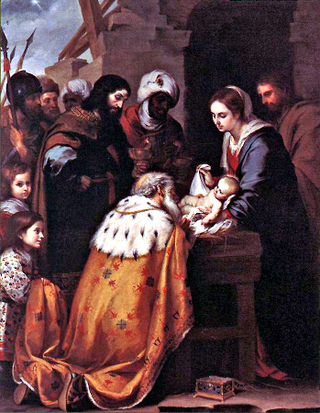
Today’s feast celebrates the
epiphaneia—that is, the appearance
and manifestation—of God in the form of a man, Jesus of Nazareth. Down through
time, between the East and the West, the feast has focused to varying degrees
on three key events: the visitation of the Magi, the baptism of Jesus in the
Jordan, and the turning of water into wine at the wedding feast of Cana. Each
of these events manifests and reveals the truth of the Incarnation and spills
forth the glory of God.
The magi, traveling afar
(likely from Persia), paid homage to the newborn King of kings. They represent
the first of the Gentiles brought into the family of God through the
Christ-child (see Catechism of the Catholic Church, par. 528). St. Paul, in today’s epistle, writes of
the “mystery” that “the Gentiles are coheirs, members of the same body,” the
Church. The “catholic” nature of the new covenant would, of course, prove to be
a source of consternation and conflict, just as the questions asked by the magi
would provoke Herod to jealousy and rage.
We are so familiar with the story of the magi that it is possible to be dulled
to the paradox of wealthy, educated rulers from the East bestowing precious
gifts upon a Jewish baby in a humble home with a dirt floor. Was the star
enough to convince them of the baby’s importance? Pope Benedict XVI, in his
2007 homily for this feast day, said there was something more. “In comparison
with King Herod,” he said, “beset with his interests of power and riches, the
Magi were directed toward the goal of their quest and when they found it,
although they were cultured men, they behaved like the shepherds of Bethlehem:
they recognized the sign and adored the Child, offering him the precious and
symbolic gifts that they had brought with them.”
What
the magi recognized, by God’s grace, was the presence of glory, light, and
splendor, cradled in the arms of Mary, the mother of Jesus. Today’s Old
Testament reading from the prophet Isaiah describes how darkness and thick
clouds “covers the peoples”—the nations of the earth—but that light has come to
Jerusalem, “the glory of the Lord shines upon you.” Many of the Jews rejected
the light, just as some walked in it, as did Mary, the mother of God. Nations,
rulers, men, and women choose to either see the splendor or to retreat into the
darkness.
During
Advent, we anticipated the parousia—the
presence—of the King; the Feast of the Epiphany marks the fulfillment of that
anticipation. The glory that slowly lit the Advent sky has now burst forth in
the person of the Son. If Christmas is the celebration of God quietly invading
the dark lands of humanity, Epiphany is the celebration, in part, of man recognizing
the love and light of the invasion.
“The
glory of God,” the Catechism
teaches, “consists in the realization of this manifestation and communication
of his goodness, for which the world was created” (par. 294). Man was made to
share in God’s glory, and God’s glory is demonstrated in the salvation of man.
To
God alone be glory. Soli Deo Gloria!
(This "Opening the Word" column originally appeared in the January 3, 2010, edition of Our Sunday Visitor newspaper.)
January 4, 2013
"Best Books I Read in 2012" coming soon!
Dorothy Day: A Saint to Transcend Partisan Politics
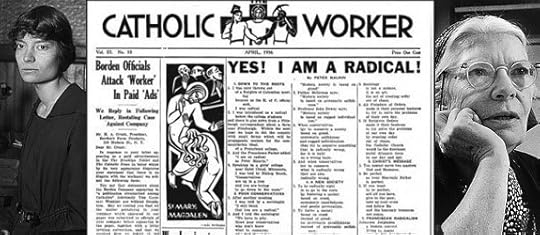
Dorothy Day: A Saint to Transcend Partisan Politics | Leslie Fain | Catholic World Report
Despite attempts from both liberals and conservatives, Dorothy Day does not fit comfortably in either political camp.
Thomas More, the statesman who would not compromise his
faith at the behest of King Henry VIII, was elevated to sainthood during a time
when Stalin, Hitler, and Mussolini were rising to power. Now, as the United
States seems to be locked in a red state/blue state quagmire, the Catholic
Church may elevate to sainthood Dorothy Day, a servant of God who could not be
pigeonholed as a liberal, conservative, Democrat, Republican, or libertarian,
and chose to wear no other label than that of Christian.
Last month during their annual meeting, the United States
Council of Catholic Bishops (USCCB) voted to support Dorothy Day’s cause for
sainthood. To steal a line from Peter Kreeft about his heroes Jesus and
Socrates, Dorothy Day certainly has something to offend everyone.
Founding the Catholic Worker movement during the Great
Depression, Day and her colleague Peter Maurin farmed, fed the poor, and
published a newspaper to protest wars and the unjust treatment of workers.
Although Day is widely accepted by the religious left because of her antiwar
stance, as well as her dedication to civil rights, workers’ rights, and the poor, Day has met with a cool reception from
many on the right. A host of conservatives, from Rush Limbaugh’s callers to
Glenn Beck, to writers and commenters at conservative websites and blogs, have
opined that Day was a Communist who flouted Church teachings. These
conservatives never provide proof, but only make statements to the effect that
she was trying to push the Church in a Communist direction.
This is a shame, as Day’s life has a lot to offer the
orthodox Catholic. “Dorothy Day constantly lived her life according to a ‘higher
obedience’ that was not subject to political instrumentalization,” said Dr.
Chad C. Pecknold, assistant professor of historic and systematic theology at the
Catholic University of America, and author of Christianity and Politics: A Brief Guide to the History (Cascade,
2010). “Advancing her cause—especially in the wake of the recent presidential
election in which the Catholic vote was divided by a political calculus that
her life rejects—is providential for the Church in America.”
Tom Cornell, a deacon assigned to St. Mary’s Parish in Marlboro,
New York and co-manager of Peter Maurin Farm, served with Day at the Catholic
Worker when he was a young man. In fact, he calls Day his matchmaker, as he and
his wife, Monica, literally met over a Catholic Worker soup pot. He agrees that
the bishops’ push for Day’s canonization is providential. “Dorothy is a bridge
between the so-called left and the so-called right in a polarized church.” He
adds, “I don’t think the labels are very helpful.”
Robert Ellsberg, the publisher of Orbis Books and editor of
All the Way to Heaven: The Selected
Letters of Dorothy Day, knew Day the last five years of her life, and agrees
that she is a bridge figure. “She is a symbol of common ground whose witness
could bring together people,” he said.
“She didn’t just communicate with Catholics,” Ellsberg
added. “She was in touch with Protestants, Jews, and unbelievers, and trying to
seek common ground.”
Day continues to be something of an enigma to many.
January 3, 2013
Catholics and Depression
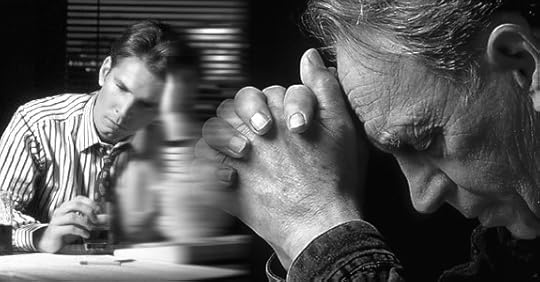
Catholics and Depression
| CWR Staff | Catholic World Report
A new book co-authored by
a psychiatrist and a priest offers faithful wisdom and learned guidance in
dealing with depression and anxiety.
Dr. Aaron Kheriaty, MD, is
the author, with Msgr. John Cihak, STD, of the book, The
Catholic Guide to Depression: How the Saints, the Sacraments, and Psychiatry
Can Help You Break Its Grip and Find Happiness Again (Sophia Institute Press, 2012). Dr. Kheriaty
is the Director of Residency Training and Medical Education in the Department
of Psychiatry at the University of 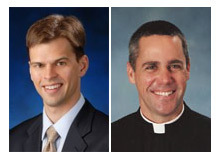 California, Irvine. He co-directs the
California, Irvine. He co-directs the
Program in Medical Ethics in the School of Medicine, and serves as chairman of
the clinical ethics committee at UCI Medical Center. Dr. Kheriaty graduated
from the University of Notre Dame in philosophy and pre-medical sciences, and
earned his MD degree from Georgetown University. Msgr. Cihak is a priest of the
Archdiocese of Portland in Oregon who currently works in the Vatican. He helped
to start Quo Vadis Days camps
promoting discernment and the priesthood at the high school level that now
operate in several U.S. dioceses. He has been a pastor and served in seminary
formation.
Their book “reviews the
effective ways that have recently been devised to deal with this grave and sometimes
deadly affliction — ways that are not only consistent with the teachings of the
Church, but even rooted in many of those teachings.” The authors were recently
interviewed by Carl E. Olson, editor of Catholic World Report, about the serious challenges posed by
depression and how those challenges can be best addressed through faith,
clinical science, and other means.
CWR: The topic of depression is fairly
commonplace, but you note that there is no simple definition of
"depression". What are some of the major features of depression? Is
it just an emotional state, or more?
Dr. Kheriaty: Depression is more than just an
emotional state, though of course it typically involves profound changes in a
person’s emotions. Sadness and anxiety
are the most common emotional states associated with depression, though anger
and irritability are also commonly found in depressed individuals. Depression affects other areas of our
mental and physical life beyond our emotions. Depressed individuals typically
experience changes in their thinking, with difficulty concentrating or focusing,
and a lack of cognitive flexibility.
Depressed individuals develop a kind of “tunnel vision” where their
thoughts are rigidly and pervasively negative. In many cases, suicidal thinking is present, driven by
thoughts or feelings of hopelessness and despair. A person with depression often feels physically drained,
with low levels of energy, little or no motivation, and slowed movements.
Another feature of
depression is what psychiatrists called “anhedonia”, which is the inability to
experience pleasure or joy in activities that the person would typically enjoy. Sleep is often disturbed, and the
normal sleep-wake cycle is disrupted. 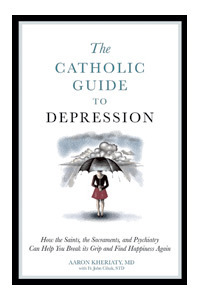 Changes in appetite are common, often with consequent weight loss or
Changes in appetite are common, often with consequent weight loss or
occasionally weight gain (in so-called “atypical depression”). So we see that depression involves many
mental and physical changes, and affects not just a person’s emotions, but also
their physical health and their ability to think clearly and act in the world.
CWR: Christians sometime think, or are
tempted to think, that depression is a sign of spiritual failure or evidence of
a lack of faith. What are the problems with, and dangers of, such perspectives?
Dr. Kheriaty: The problem with this perspective is
that it does not recognize that depression is a complex illness with many
contributing factors. While we
acknowledge in The Catholic Guide to Depression that spiritual or moral factors can be
among the causes, we also argue that there are many other factors that play a
role in the development of depression, many of which are outside of the patient’s
direct control – biological factors, genetic predispositions, familial and
early attachment problems, interpersonal loss, traumatic experiences, early
abuse, neglect, and so on. If we
attend only to the spiritual or moral factors, then we do the person a
disservice by ignoring other important contributing elements that often play a
significant role in depression.
With that said, the spiritual factors, and other behavioral factors
within a patient’s control, should not be ignored either. We wrote this book, in part, as a way
to bring the medical, social, and biological sciences into dialogue with
philosophy, theology, and Catholic spirituality, in order to gain a fuller and
more comprehensive understanding of this complex affliction. We hope that this multifaceted approach
will help people more adequately address depression from all of these
complementary perspectives.
Msgr. Cihak: I would completely agree. I think
perhaps sometimes in our desire to get to the bottom of things, we can tend to
oversimplify the situation. As Dr. Kheriaty said, there can be many
contributing factors. The book reflects an intentionally Catholic approach by
integrating the truths of medicine, philosophy and faith. We should keep the
whole in mind as well as the deep connection between the body and the soul. In
our respective vocations, we have both encountered people suffering from
depression who actually manifest a strong faith, which they themselves might
not be able to see, but which has been helping them to keep going in the tough
times. That being said, we attempt to demonstrate in the book that our Faith
has profound things to say about depression, its deepest theological origins,
its redemption by Jesus Christ and its transformation in His Church.
CWR: Are psychiatry and Christian faith in
opposition to one another? If not, how can Christians discern between the
benefits of psychiatry and problematic theories, for example, Freudian or
Jungian accounts of religious belief and human relationships?
January 2, 2013
Papal Nuncio to Join Walk for Life West Coast
From the good folks organizing the Walk for Life West Coast:
Organizers delighted with presence of Archbishop Carlo Maria Viganò at January 26 event
January 2, 2013 – The Walk for Life West Coast is honored to announce that Archbishop Carlo Maria Viganò, the Holy Father’s Ambassador to the United States, will be attending the 9th Annual Walk for Life West Coast in San Francisco, on January 26, 2013.
“What an honor! We are so excited—this is the next best thing to having the Holy Father himself with us!” said Eva Muntean, a co-founder of the Walk. Archbishop Viganò, appointed on October 19, 2011, the Feast of the North American Martyrs, is the 14th Papal representative to the United States. The diplomatic post was established in 1893.
The 2013 event will begin at 12:30 PM in the city’s Civic Center Plaza. The rally and Walk will be preceded in the plaza by an Info Faire, beginning at 11:00 AM, and a “Silent No More” awareness campaign, featuring actress Jennifer O’Neill (www.jenniferoneill.com) beginning at 10:45 AM. Rally speakers include:
• Lacey Buchanan, a young mother whose YouTube video about her blind son went viral and has touched over 11 million viewers (her video was voted the #3 video of 2012 on Godvine.com);
• Elaine Riddick, a woman who was forcibly sterilized at age 14 under orders from North Carolina’s Eugenics Board, whose goal was to purify the state’s population by weeding out the mentally ill, diseased, feebleminded and others deemed undesirable;
• Rev. Clenard Childress, the founder and director of www.BlackGenocide.org , a website designed to reach the African-American Community with the truth about abortion;
• Kelly and Matthew Clinger, a post-abortive couple who share their story about the heartache and pain caused by life in the music industry, divorce, addiction, and abortion.
Following the rally, Walkers will march down Market Street to Justin Herman Plaza.
Founded in 2005 by a group of San Francisco Bay Area residents, the Walk for Life West Coast’s mission is to change the perceptions of a society that thinks abortion is an answer. Walk participants are expected from throughout the Bay Area and across the United States and Canada.
More details at: www.walkforlifewc.com.
Getting to Know the Greek Fathers

Getting to Know the Greek Fathers | Alcuin Reid | The Foreword to Adrian Fortescue's
The Greek Fathers: Their Lives and Writings
As ever when approaching one of Adrian Fortescue's works, prepare yourself for
a treat. For in these pages we will travel extensively throughout the ancient
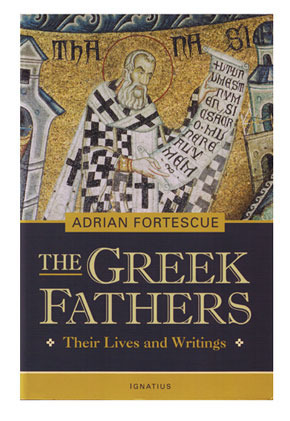
Christian East, from Alexandria to Caesarea, from Constantinople to Jerusalem,
to Alexandria again and thence to Damascus, "the real eternal city"
in Fortescue's estimation.
We will be introduced as if in person to the great Greek Fathers of the fourth,
fifth and eighth centuries of the Church's history: to the great Father of the
Christological debates, Saint Athanasius; to Saint Basil, "one of the
greatest of that younger generation of Catholic bishops who carried on the
fight that Athanasius had fought and finally stamped out the Arian heresy".
We will meet Saint Basil's dear friend, Saint Gregory Nazianzen, "the
patron saint of people who do not want to be bishops", and Saint John
Chrysostom, the "great model and patron of preachers". There are also
two Saints Cyril to encounter: the first, of Jerusalem, who spent sixteen of
the thirty-five years of his episcopate in banishment, and the second, of
Alexandria, the champion of the Mother of God against the Nestorian heresy.
Finally we will meet the eighth-century Saint John of Damascus, the first of
the Christian Aristotelians who lived his entire life under Muslim rule.
Through Fortescue's introductions we will learn Catholic theology by reliving
the gritty events in which it was originally hammered out. We will see its
champions suffer and at times take questionable paths. Yet we will also witness
their fortitude and perseverance and glimpse in their struggles a tangible
sanctity from which any age--not least our own--can learn very much indeed.
For Adrian Fortescue (1874-1923), a true polyglot, while an utterly English
Roman-rite priest, possessed the heart of an Eastern Catholic. He travelled
extensively in the East and wrote prolifically about their churches, doing much
to raise the awareness of many Westerners in respect of the life and traditions
of our Eastern brethren. So Eastern were Fortescue's sensibilities that in 1908
he seriously considered giving his priestly services to Cyril VIII, the Melkite
Catholic Patriarch of Damascus (1902-1916), with whom he had stayed for the
greater part of December 1906. The Patriarch was prepared to go personally to
Pope Saint Pius X in order to gain Fortescue's release from England to work in
Damascus.
In fact, it was with this prospect uppermost in his mind that Fortescue wrote The
Greek Fathers. For in the same letter (February 16, 1908) in which
he confided his Damascene aspirations to a close friend, he reported:
Now I am tearing through John
Chrysostom (nice person) and making purple patches about the great and
God-beloved city of Antioch. He ought to be done on Wednesday; then Gregory of
Nazianzum (I can't stand him), two Cyrus & John Damascene (meek person who
loved Damascus--like me in many ways). They ought to all be done in a
fortnight.
But Fortescue remained in England. Later that year he wrote
(November 30, 1908) that Cyril VIII was angry with him because "I am shut
up in a distant grey island under cloudy skies; but my soul is back in the land
of Syria sleeping under the apricot trees, where the waters of Barada splash in
the fountains under the hot sky and the camels growl by the shady vaults of the
gates." Under those grey skies he continued faithfully to pastor his small
new parish of Saint Hugh, Letchworth, to write his "purple patches"
on the Christian East and to love the Church Catholic, East and West.







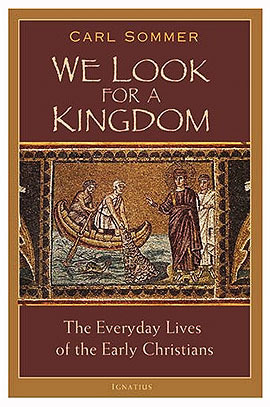
[image error]

Fortescue's love for the East, combined with his refined intelligence and wide
experience of the East, is why he is such a reliable guide. And it is one
reason why, a century later, one ought to read this book. Certainly, much has
been written about these Fathers in the intervening years, but his passion for
the people, events and churches that this work encompasses retains its value.
Fear not his style. As the above excerpt from his correspondence illustrates,
he frequently says what he thinks. And his ecclesiology is stark, as stark as
that of the subjects of these biographies, indeed, perhaps too much so for some
contemporary ears. Yet his straight-speaking comes from his conviction that a
man must speak the truth, and if his writing thus helps us to examine our own
tendency to obfuscate it, perhaps he has done us good service thereby.
Not unnaturally Adrian Fortescue's considerable gifts led him to dream of
becoming the bishop's secretary, of eventually himself donning the bishop's
purple and even a cardinal's hat. That was not to be. As well as contemplating
becoming a priest of an Eastern Catholic Church, in 1909 he sought admission to
the Benedictine Abbey of Melk in Austria. This, too, never came to pass. In
God's Providence his lot remained that of the founding rector of a small rural
parish. He considered himself "not really very good" at parish work,
yet he boasted to friends that his little church was "the only church
worth looking at west of Constantinople". After his early death from
cancer in 1923 it became apparent just how fine a pastor he in fact had been,
and indeed how fine a church he had built.
Indeed, Fortescue "scribbled" day and night in order to make ends
meet. Nothing but the best would suffice for the parish of Saint Hugh. His
writings were an exercise of his scholarship, yes, but they were above all an
oblation ordered to the greater glory of Almighty God. They were also ordered
to the edification of the Church. For as retiring and sensitive as Fortescue
was by nature, he could not allow an opportunity to. pass wherein he was able
to introduce others to aspects of Catholic tradition of which they were
unaware--he was a natural and gifted teacher. Hence this volume's thoroughly
enjoyable, profound introduction to our Greek Fathers.
When we have travelled the East with Fortescue these Fathers will no longer be
mere figures of early Church history. Yes, we shall have enjoyed Fortescue's
style and yes, we shall have grown in wisdom and knowledge from his erudition.
But we shall also have gained some new friends, the great Fathers of the early
Eastern Church, to whom in this life, as we strive faithfully to live and hand
on the faith that was theirs, we can turn in the communion of saints for the
benefit of their example and the assistance of their intercession, especially
on their liturgical feasts, and with whom we hope to enjoy the next. Please God
our guide, also, is in a position to assist us today not only through his
writing of a century ago, but also with his prayers.
Alcuin Reid
March 27, 2007
Related IgnatiusInsight.com Articles, Book Excerpts, and Interviews:
• Selections from Jesus, The Apostles, and the
Early Church | Pope Benedict XVI
• St. Ignatius of Antioch and the Early Church | Kenneth D. Whitehead
• A Short Guide to Ancient Heresies | Kenneth D. Whitehead
• Studying The Early Christians: The Introduction to We Look For
the Kingdom | Carl J. Sommer
• The Everyday Lives of the Early Christians | An interview with Carl J. Sommer
• Church and State in Early Christianity | Hugo Rahner, S.J.
• His Story and the History of the Church | An Interview with Dr. Glenn W. Olsen
• Are We at The End or The Beginning? | Dr. Glenn Olson
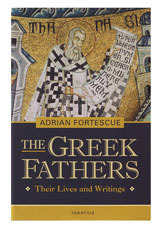
The Greek Fathers: Their Lives and Writings
Adrian Fortescue
The Fathers of the Church were great, holy men of history who lived in
the early centuries of Christianity and made a significant impact on
the Church and society by their lives and their teachings &
writings. There are various groups of such men considered to be Fathers
of the
Church, and this work focuses on the lives, adventures and central
teachings of the great Greek Fathers, whose names are well-known in the
history of the Church.
The author covers seven Greek Fathers who lived between the years 293 to
754, most of them living in the 200-400's. These are St. Athanasius
(293-373), St. Basil (330-379), St. Gregory Nazianzos (330-390), St.
John Chrysostom (344-407), St. Cyril of Jerusalem (315-386), St. Cyril
of
Alexandria (+444) and St. John of Damascus (+754).
This work gives popular sketches of these great saints, focusing more on
their lives than on their theology, and is meant for the inspiration
and illumination of the layman. These men are important, great figures
of history to know about, men who were mighty patriarchs or famous
bishops,
who lead councils, resisted Caesar and suffered persecution for Christ.
Their lives and dramatic witness stand out as a bright beacon of light
for us all.
Adrian Fortescue was a priest, author and highly respected scholar from England who lived in the early twentieth century. He wrote
several books on Church history and on the liturgy.
Carl E. Olson's Blog
- Carl E. Olson's profile
- 20 followers



